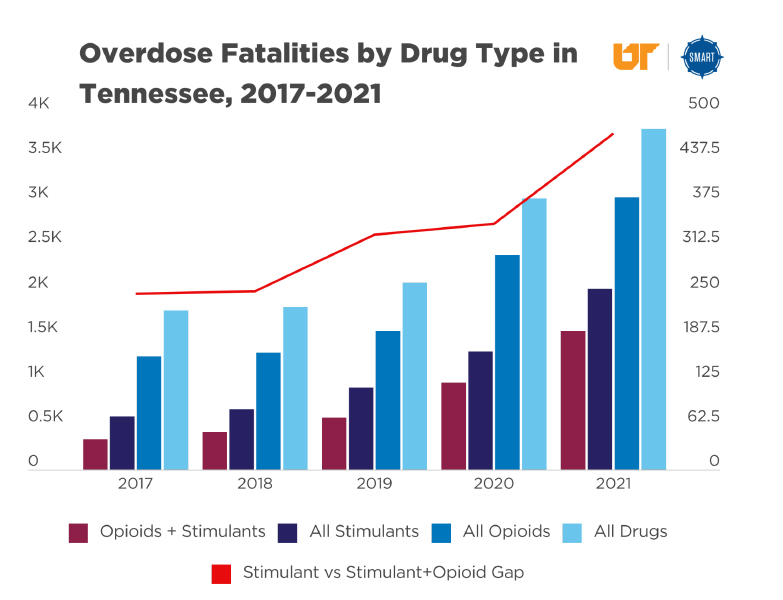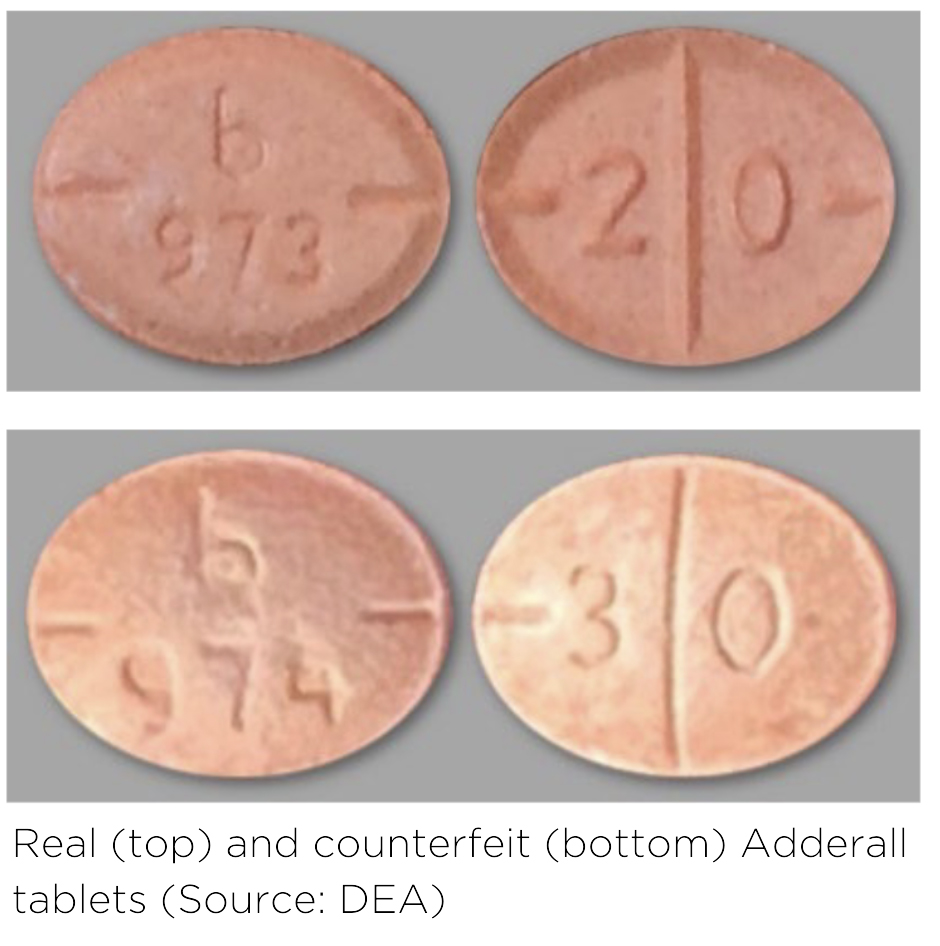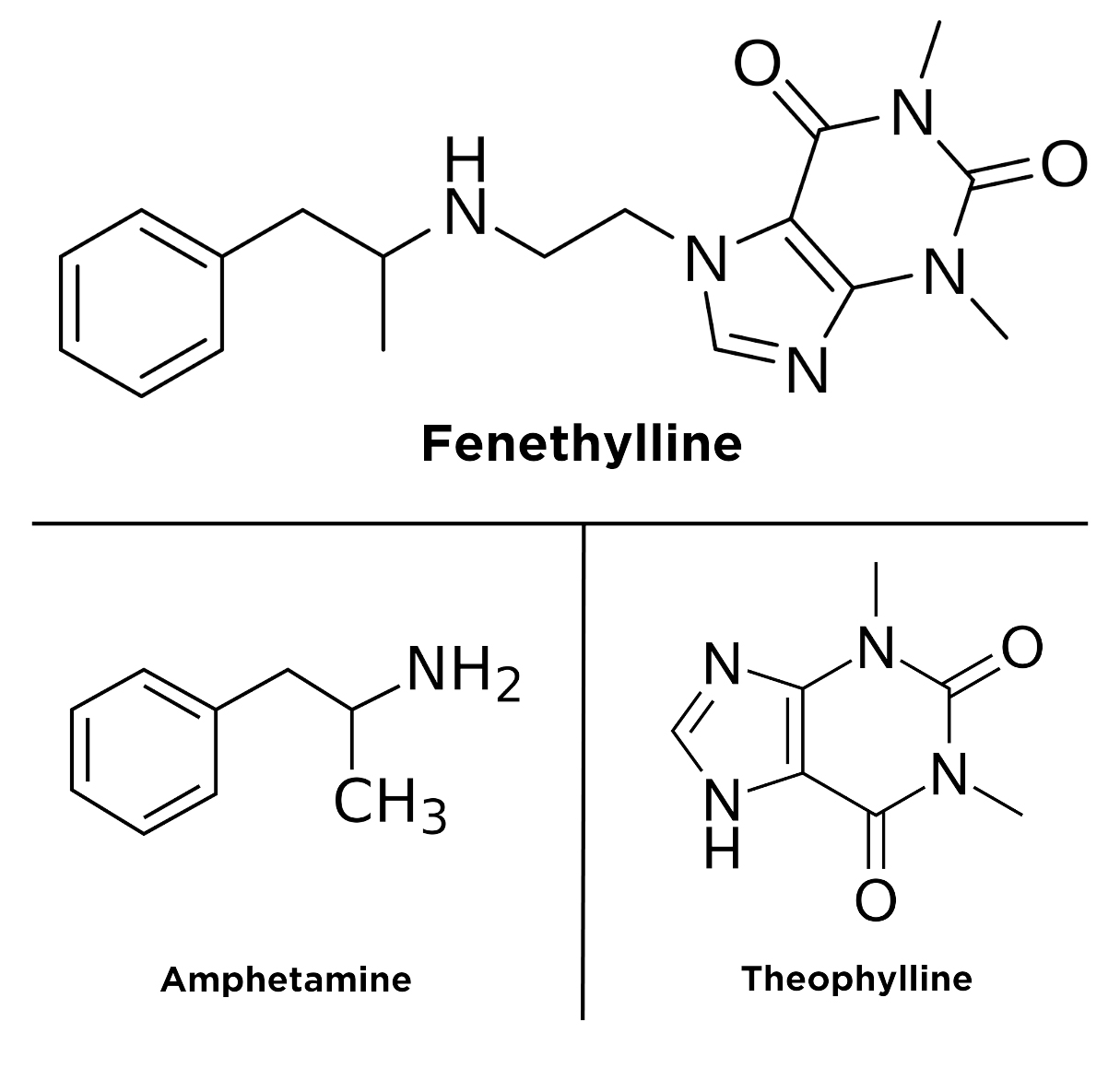What is the Risk of “Captagon” and Other Pill-Pressed Stimulants in Tennessee?
Key Points
|
The Demand for Stimulants is Growing, Particularly for Amphetamines
While fentanyl and other synthetic opioids are driving the vast majority of overdose fatalities, the demand for stimulants, particularly cocaine, methamphetamine and amphetamine, remains strong and is growing in Tennessee and in the U.S. broadly.
The following graph depicts statewide overdose fatality data in Tennessee from 2017-2021 for overdoses involving all drugs, all stimulants, and those involving both opioids and stimulants. The y axis on the left shows total count. Looking at the stimulant and opioid+stimulant data, it is clear that opioids are involved in the vast majority of all stimulant-involved fatalities. However, as depicted by the red trend line (the data for which is delineated in the y axis on the right), one can see that the gap between deaths involving just stimulants and those involving both stimulants and opioids is widening. In other words, the number of deaths involving stimulants without opioids is increasing at a higher rate than those deaths involving both stimulants and opioids.

While there are several potential contributing factors (such as reports of methamphetamine samples of increased potency, adulterants including non-opioid drugs and chemicals, riskier use behaviors such as injecting as opposed to smoking, etc.), it is clear that deaths involving stimulants are rising, and opioid involvement is not the only contributing cause.
“Methamphetamine is the number one drug that’s being seized by law enforcement across the state, and the potency level has never been stronger than what it is right now.” – SAC Tommy Farmer, Director of the TBI Dangerous Drugs Task Force
Nationwide, overdose deaths involving stimulants other than cocaine (primarily methamphetamine) increased by 180% between 2015-2019. For comparison, deaths involving opioids increased by about 51% in that same time period. The largest driver of the fatalities involving stimulants is undisputedly fentanyl contamination and mixing. However, reported use of methamphetamine without use of any additional drugs increased by 43% during the same time period. Furthermore, reports of frequent use (defined as over 100 days per year) of methamphetamine and methamphetamine plus cocaine both increased by 66% and 60% respectively, also during the same time frame. So while fentanyl still poses the largest risk for fatalities overall, it cannot be ignored that the demand for amphetamines is climbing rapidly, as are higher-risk use patterns of these drugs.
“Now the users are saying ‘I don’t want to deal with that fentanyl, I’ll go back to methamphetamine.’ Well, the cartels know what we desire.” – Former SAC Karl Colder, U.S. Drug Enforcement Administration
The Ongoing Shortage of Prescription Stimulants Creates a Potential Risk
The persistent nationwide shortage of prescription stimulant medications for the treatment of ADHD and other conditions such as Adderall (amphetamine and dextroamphetamine salt) may be contributing to a surge in overdoses involving methamphetamine and other stimulants.
It is estimated that over 8% of adolescents report medical use of prescription stimulants and over twice that many (16.7%) admit to nonmedical misuse by age 18. Prescription stimulant misuse is indeed on the rise, having increased “by approximately 67%” among the general adult population,” and “emergency room visits [involving prescription stimulants] rose by approximately 156% between the years of 2006 and 2011.”
It has been reported that the illicit market for diverted Adderall is booming, and alongside it the sale of counterfeit pills containing methamphetamine, acetaminophen, caffeine, and other substances that are masquerading as Adderall and other prescription drugs. In September, 2022, an individual pleaded guilty of possession with intent to sell over 660,000 counterfeit Adderall pills that actually contained methamphetamine, and similar counterfeit pills have been found being sold in Mexican pharmacies. A drug testing clinician for the Chicago Recovery Alliance told the Chicago Sun-Times that many people have turned to methamphetamine due to an inability to acquire prescription stimulants. Nicholas Roti, director of Chicago HIDTA, also told the Chicago Sun-Times that he is seriously concerned about methamphetamine and other substances being sold as counterfeit Adderall or other prescription drugs. Some counterfeit “Adderall” pills have even been found to contain fentanyl, contributing to the deaths of two college students in Ohio.

In the Middle East, the most popular illicit substance is a counterfeit stimulant known as “Captagon.” While it is commonly consumed by militant groups, it is popular among college-aged students and a significant percentage of the adult population due to the low cost of the drug as well as its reputation as a relatively safer “party drug”. Data do not currently show a significant presence of “Captagon” in Tennessee, but this substance serves as a strong example of the type of threat posed by the combination of high demand for stimulants but a restricted supply of legitimate prescription medications, all in the backdrop of widespread sale of pill-pressed counterfeit drugs.
The Risk of “Captagon”
Captagon is the brand name of a drug that was originally synthesized and sold in Germany in the 1960s for the treatment of “hyperkinetic” children (a condition known today as ADHD), as well as depression and narcolepsy.
The active ingredient is fenethylline (sometimes spelled fenetylline), which is both a codrug and prodrug of (meaning it is both composed of and metabolizes into) amphetamine and theophylline. Theophylline, which is almost structurally identical to caffeine, is a bronchodilator used to treat COPD and asthma, and naturally occurs in miniscule quantities in coffee, tea, chocolate, and other similar plants.

The nature of fenethylline’s chemistry is relevant to both its production as well as efforts to detect it. Amphetamine is required as a precursor chemical to produce it, and when it is consumed, fenethylline breaks down into amphetamine, meaning that toxicology screens have to be carefully analyzed in order to determine whether the tested individual potentially consumed fenethylline or simply amphetamine.
Studies on the effects of fenethylline showed that it had comparable potential therapeutic uses to amphetamines (for the treatment of hyperactivity, depression, narcolepsy, etc.), and for a few years the drug was approved in Germany for these uses. Fenethylline does have side effects that are also comparable to amphetamine and methamphetamine, but importantly they are not as severe – particularly so the impact on blood pressure, appetite reduction, fine motor tremor, mood alteration, sleep disturbances, etc. – and it is believed that the abuse potential is lower than with amphetamine. Regardless, due to these side effects and the fact that an investigational new drug application was never filed with the U.S. Food and Drug Administration (FDA) – and thus no documented medical use ever established in the United States – fenethylline was ultimately classified as a Schedule I drug in 1981 and subsequently banned in 1986.
Though legal manufacturing of fenethylline (under the brand names Captagon, Biocapton and Fitton) has been banned for nearly 40 years, illicit manufacturing has continued and is growing in scale, primarily in countries across southeastern Europe including Turkey, Bulgaria, Slovenia, Serbia and others, from where it was exported to the Near and Middle East. “Captagon”-branded tablets are the dominant version by far (as opposed to other brand names mentioned above), accounting for 99% of all amphetamines seized by law enforcement in the Middle East.
Actual Fenethylline is Rare; Essentially All “Captagon” Tablets are Other Drugs
In a recent gas chromatography tandem mass spectrometry analysis of seized “Captagon,” it was found that “all tablets had a high yield of amphetamine and caffeine, starting materials in the synthesis of fenethylline, with complete absence of the latter compound.” [Emphasis added]. Dozens of other adulterants were also discovered, including acetaminophen, lidocaine, simvastatin, quinine, dextromethorphan, and others, indicating careless or incompetent manufacturing methods. In other words, there really is no fenethylline trade; it’s all amphetamines and contaminants in counterfeit pressed pills.
The presence of adulterants could be due to improper manufacturing or packaging, leading to the unintentional creation of byproducts through degradation, cross reaction, or other reasons, or they could be intentionally added for increased potentiation (such as mixing in quinine and caffeine). Another potential explanation could be a cost-benefit analysis on the part of the manufacturer. As amphetamine is a required precursor to fenethylline, but amphetamine itself is already highly lucrative, it could be that the manufacturer would stop synthesizing at amphetamine and market the product from there, benefitting from the “Captagon” brand as a relatively safer alternative while reducing the cost of further chemical processes to render actual fenethylline. However, due to a lack of documentation of analysis of seized tablets in some countries, these potential reasons are speculative.
“Captagon” is the most popular drug in Saudi Arabia, and seizures of the drug in that country make up 80% of all seizures across the Middle East as well as 30% of all amphetamines seized globally. “Captagon” is also increasingly popular among militant groups such as the Islamic State in Iraq and Lebanon (ISIL, formerly known as ISIS), and in recent years, manufacturing has increased in the Syrian Arab Republic, and the trade of illicit “Captagon” is heavily tied to weapons and ammunition trafficking. The market for the drug is rapidly growing, with the estimated value literally doubling from $3.46 billion in 2020 to over $5.7 billion in 2021, and expanding from the Near and Middle East to include North Africa, southern Europe, and potentially additional destinations beyond.
How Would “Captagon” Come to Tennessee?
While it is estimated that there are about 800 illicit drug labs operating at any given time in Tennessee, the majority of the illicit amphetamine-type stimulant supply in Tennessee (which is mostly methamphetamine) is imported from other countries, primarily Mexico, and is inextricably linked to organized crime. “Captagon” is not currently produced or “widely available” in the United States, and there is also currently no evidence that traditional sources of amphetamines in North America – such as the cartels in Mexico – are manufacturing “Captagon.” As mentioned, it is produced almost exclusively in southeastern Europe and the Middle East, particularly the Syrian Arab Republic. However, while the market is currently almost exclusively in the Near and Middle East, international drug trafficking experts are already warning that the trade is rapidly expanding to Europe and potentially beyond. Some of the more recent seizures in Europe indicate that production has grown in scale, from small, mobile laboratories to “industrial-sized clandestine facilities,” and constant monitoring is urged “especially as traffickers adopt more sophisticated methods of smuggling.” “Darknet” or “dark web” channels should be of particular focus.
Recently, the Sinaloa Cartel, the largest importer of fentanyl into the U.S., announced within its territory that it would no longer permit the production and distribution of fentanyl. While experts doubt the sincerity of this ban or if it would last for a significant amount of time, it is expected that shipments of methamphetamine, cocaine, and heroin will increase in the near future as a result. Such drugs are already being widely sold in the U.S. to youth, as evidenced by New Mexico’s public school wastewater monitoring program, which identified amphetamine, methamphetamine and cocaine at the vast majority of all high school campuses tested.
Data provided to the SMART Initiative by Appalachia HIDTA show that while methamphetamine and cocaine remain the predominant type of stimulant seized in major drug trafficking areas in Tennessee, there was a sharp increase in seized prescription stimulants between 2021-2023, especially amphetamines like Adderall. 2022 in particular saw a massive increase in volume of seized amphetamine pills in Knox County, the same year the FDA announced a shortage of Adderall. Considering multiple universities and colleges are located in that and adjacent counties, this illustrates the potential risk that illicit pill-based amphetamines pose, especially in the context of prescription stimulant shortages.
Tracking Fenethylline Is Difficult…but Testing for Amphetamine is Common
Because it is both a codrug and prodrug of amphetamine, fenethylline is metabolized into amphetamine and thus a routine urine drug screen would not be able to differentiate between them. Some specialized tests do exist that can detect fenethylline in urine, but the practice is relegated mainly to sports-related screening. Due to being included on the World Anti-Doping Agency’s list of banned substances, WADA-accredited laboratories can and do test for fenethylline, but there are only two such laboratories in the United States at this time (in California and Utah). Labs not affiliated with WADA may also test for fenethylline, but we have not yet found any.
We spoke with numerous forensic centers throughout Tennessee and the Appalachian region and found that none currently test for fenethylline. This could be for many reasons, but first and foremost simply because the drug has been extremely rare for half a century and was never popular in the United States to begin with. This problem is not unheard of within the context of the drug crisis, wherein novel psychoactive substances are constantly being created and trends in use and manufacturing change. Testing for fentanyl was similarly rare until the last few years for the same reason.
That being said, with actual fenethylline being extremely rare and basically all counterfeit “Captagon” tablets being composed of amphetamine, caffeine and other adulterants, this lack of testing for fenethylline is only an issue so long as fenethylline itself does not become common. Counterfeit pills containing amphetamine would be easily detected, due to widespread testing for amphetamine across healthcare, medical examiners, and law enforcement.
Conclusion
Due to widespread and growing demand for amphetamine-type stimulants in the United States, rising rates of prescription stimulant misuse and use disorder in particular, an ongoing shortage of legitimate prescription stimulants, a firmly established market for counterfeit pills (which often contain fentanyl, xylazine and other contaminants), and shifting production and export trends by cartels in Mexico to prioritize methamphetamine, there is a strong potential market for drugs like “Captagon,” which masquerade as legitimate ADHD medication. This potential market would carry significant risk of medical injury or overdose death, which is what we already see with counterfeit opioid pills that contain fentanyl.
The “Captagon” market as currently observed and described poses the challenge of improperly produced counterfeit pills containing amphetamine and other drugs and contaminants. As of now, “Captagon” has not been seen at scale in the United States, but due to the nature of this drug and the potential domestic market, it and drugs like it pose a potential risk to Tennessee. “Captagon” is not the only such drug that could fill this widening niche; any synthetic stimulant could be pressed into a pill and sold as Adderall or Ritalin or some other legitimate prescription pill.
Overall, such a market for counterfeit prescription stimulants is a concern worth monitoring into the foreseeable future, whether or not “Captagon” specifically ever enters the illicit supply in Tennessee.
Policy Brief Authors:
Jeremy Kourvelas, MPH, Program Coordinator,SMART Initiative
